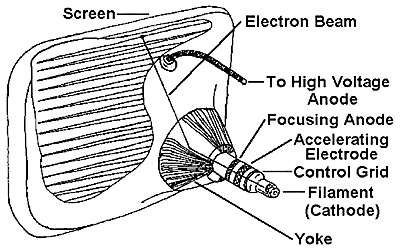Monitor Information
Information
Monitor Types Are Fallowing Types
CRT
(Cathod Ray Tube)
Pros:
- Very high contrast ratio (20,000:1 or greater, much higher than many modern LCDs and plasma displays.)
- High speed response
- Excellent Additive color, wide gamut and low black level limited only by external environment.
- Can display natively in almost any resolution and refresh rate
- Near zero color, saturation, contrast or brightness distortion. Excellent viewing angle.
- No input lag
- A reliable, proven display technology.
Cons:
- Large size and weight (a 40" unit weighs over 200lbs)
- Geometric distortion in non-flat CRTs
- Older CRTs are prone to burn-in.
- Warm up time required prior to peak luminance and proper color rendering.
- Greater power consumption than similarly sized displays, such as LCD.
- Screened devices are prone to moire effect at highest resolution (does not apply to triple-tube projection)
- Intolerant of damp conditions, with dangerous wet failure characteristics.
- Small risk of implosion (due to internal vacuum) if the picture tube is broken in aging sets.
- Use under Lower refresh rates causes noticeable flicker
- Internal lethally high voltages
- Flyback transformer produces characteristic high-pitched noise when close to set.
- Increasingly difficult to obtain models at HDTV resolutions, due to consumers' perception of antiquity.
LCD
(Liquid Crystal Display)

Pros:
- Very compact and light
- Low power consumption
- No geometric distortion
- Rugged
- Little or no flicker depending on backlight
Cons:
- Low contrast ratio.
- Limited viewing angle. This causes color, saturation, contrast and brightness to vary, even within the intended viewing angle from mere variations in posture.
- Uneven backlighting in some monitors can cause brightness distortion, especially toward the edges.
- Slow response times, which cause smearing and ghosting artifacts (although many modern LCDs have response times of 8ms or less).
- Only has one native resolution. Displaying other resolutions requires a video scaler, which degrades image quality at lower resolutions.
- Fixed bit depth, many cheaper LCDs are incapable of truecolor.
- Input lag
- Somewhat more expensive than CRT
- Dead pixels are possible during manufacturing
TFT
(Thin Film Transister)

Small liquid crystal displays as used in calculators and other devices have direct driven image elements – a voltage can be applied across one segment without interfering with other segments of the display. This is impractical for a large display with a large number of picture elements (pixels), since it would require millions of connections - top and bottom connections for each one of the three colors (red, green and blue) of every pixel. To avoid this issue, the pixels are addressed in rows and columns which reduce the connection count from millions to thousands. If all the pixels in one row are driven with a positive voltage and all the pixels in one column are driven with a negative voltage, then the pixel at the intersection has the largest applied voltage and is switched. The problem with this solution is that all the pixels in the same column see a fraction of the applied voltage as do all the pixels in the same row, so although they are not switched completely, they do tend to darken. The solution to the problem is to supply each pixel with its own transistor switch which allows each pixel to be individually controlled. The low leakage current of the transistor prevents the voltage applied to the pixel from leaking away between refreshes to the display image. Each pixel is a small capacitor with a layer of insulating liquid crystal sandwiched between transparent conductive ITO layers.
The circuit layout of a TFT-LCD is very similar to that of a DRAM memory. However, rather than fabricating the transistors from silicon formed into a crystalline wafer, they are made from a thin film of silicon deposited on a glass panel. Transistors take up only a small fraction of the area of each pixel; the rest of the silicon film is etched away to allow light to pass through.
The silicon layer for TFT-LCDs is typically deposited using the PECVD process from a silane gas precursor to produce an amorphous silicon film. Polycrystalline silicon (frequently LTPS, low-temperature poly-Si) is sometimes used in displays requiring higher TFT performance. Examples include high-resolution displays, high-frequency displays or displays where performing some data processing on the display itself is desirable. Amorphous silicon-based TFTs have the lowest performance, polycrystalline silicon TFTs have higher performance (notably mobility), and single-crystal silicon transistors are the best performers.
